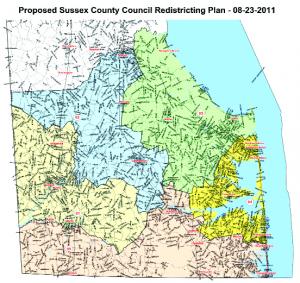Sussex council approves redistricting plan
Sussex County Council has settled on new boundaries that will shape the representation of county government for the next 10 years.
At its Nov. 15 meeting, council unanimously adopted a redistricting ordinance and accompanying maps that establish new council districts through 2021 based on last year’s U.S. Census, which showed significant growth and shifts in the population from 2000 and 2010.
The five new districts will be used to determine residency and the areas represented by council, a five-member legislative body of county government whose members are elected from individual districts. Each member serves a four-year term.
Redistricting is required every 10 years following the census. The new district maps take effect immediately.
“I believe what council has approved strikes the correct balance and satisfies a lot of diverse interests among the people and communities of Sussex County,” said Council President Mike Vincent, R- Seaford. “Drawing lines on a map can be a very subjective process, but this was about as apolitical, open and fair as any redistricting process I have ever seen.”
But not everyone was satisfied with the new plan. The main objection came from the League of Voters of Sussex County. A league committee drew up its own map that put all eastern Sussex towns in two districts, instead of the three in the newly approved plan.
Council’s adoption follows an October public hearing and a first-of-its-kind process in Sussex. Residents were invited in late June to offer suggestions – and then comments on the draft proposals – on how the new districts should look for the next decade before the ordinance was introduced. The county received more than 60 comments by email, mail and in person throughout the three-step process.
The new plan, developed by county attorney Everett Moore and consultant Richard Carter, keeps all five current council members in their seats and does not force any sitting member to run against another in the 2012 election.
Population decreased in District 1, held by Council President Mike Vincent, R-Seaford, and increased in District 3, held by Joan Deaver, D-Rehoboth Beach. There were a number of changes to the boundaries of those districts, including an increase in the size of District 1 to now include Bridgeville with Seaford and Laurel, and contraction of District 3 with the loss of most of the Milford area to District 2, held by Sam Wilson, R-Georgetown. District 4, held by Vance Phillips, R-Laurel, and District 5, held by George Cole, R-Ocean View, were relatively unchanged.
Based on census information, Sussex County’s population increased nearly 26 percent between 2000 and 2010, from 156,638 residents to 197,145 residents. Each council district must be within 5 percent of an ideal population of 39,429 residents, meaning it must contain no fewer than 37,458 residents and no more than 41,401 residents. The newly adopted plan satisfies those requirements, Moore said.
Copies of the adopted maps are available at sussexcountyde.gov.






















































